|
|
Happy New Year! Or as the Romans would say: "Annum novum faustum felicem!"
|
Welcome 2024 A.D. We start with an enchanting smile into this new year. The Etruscan head of a woman with its slender, slightly asymmetric face with almond-shaped eyes, finely drawn brows and small mouth with full red lips is the perfect epitome of archaic beauty. How magnificent must the building in Cerveteri have been, which the head adorned in the 6th century B.C.?
|
Ancient Art with Prominent Provenances. From neighbouring Chiusi originates the rare trefoil oinochoe ("Schweifhenkelkanne") depicting two satyrs, who act as athletes. It once graced the private collection of the famous French archeologist Louis-Gabriel Bellon (1819-1899). The expressive Neolithic face lid of the Vinča culture is another highlight of the by now legendary Jovanovic collection, which has been in Vienna since the early 1970s. The face depicts an owl and should protect against evil and preserve the good. This is exactly what we wish you for this upcoming year!
|
|
Prosit Neujahr! Oder wie die Römer sagen würden: "Annum novum faustum felicem!"
|
Willkommen 2024 A.D. Wir starten mit einem bezaubernden Lächeln in das neue Jahr. Der etruskische Frauenkopf mit dem schlanken, leicht asymmetrischen Gesicht mit Mandelaugen, den fein gezogenen Brauen und dem kleine Mund mit seinen vollen roten Lippen ist geradezu der Inbegriff archaischer Schönheit. Wie prachtvoll muss erst das Gebäude in Cerveteri gewesen sein, das der Kopf im 6. Jahrhundert v. Chr. als Antefix schmückte?
|
Antiken aus prominentem Vorbesitz. Aus dem benachbarten Chiusi stammt übrigens die seltene Schweifhenkelkanne, die zwei Satyre zeigt, die als Athleten auftreten. Sie stand einst in der Privatsammlung des berühmten französischen Archäologen Louis-Gabriel Bellon (1819-1899). Der ausdrucksstarke neolithische Gesichtsdeckel der Vinča-Kultur ist ein weiteres Highlight der mittlerweile legendären Jovanovic-Sammlung, die sich seit Anfang der 1970er Jahre in Wien befindet. Das Gesicht stellt eine Eule dar und sollte das Böse abwehren und das Gute bewahren. Und genau das wünschen wir auch Ihnen für das kommende Jahr!
|
|
|
|
Our Highlight of the Month:
|
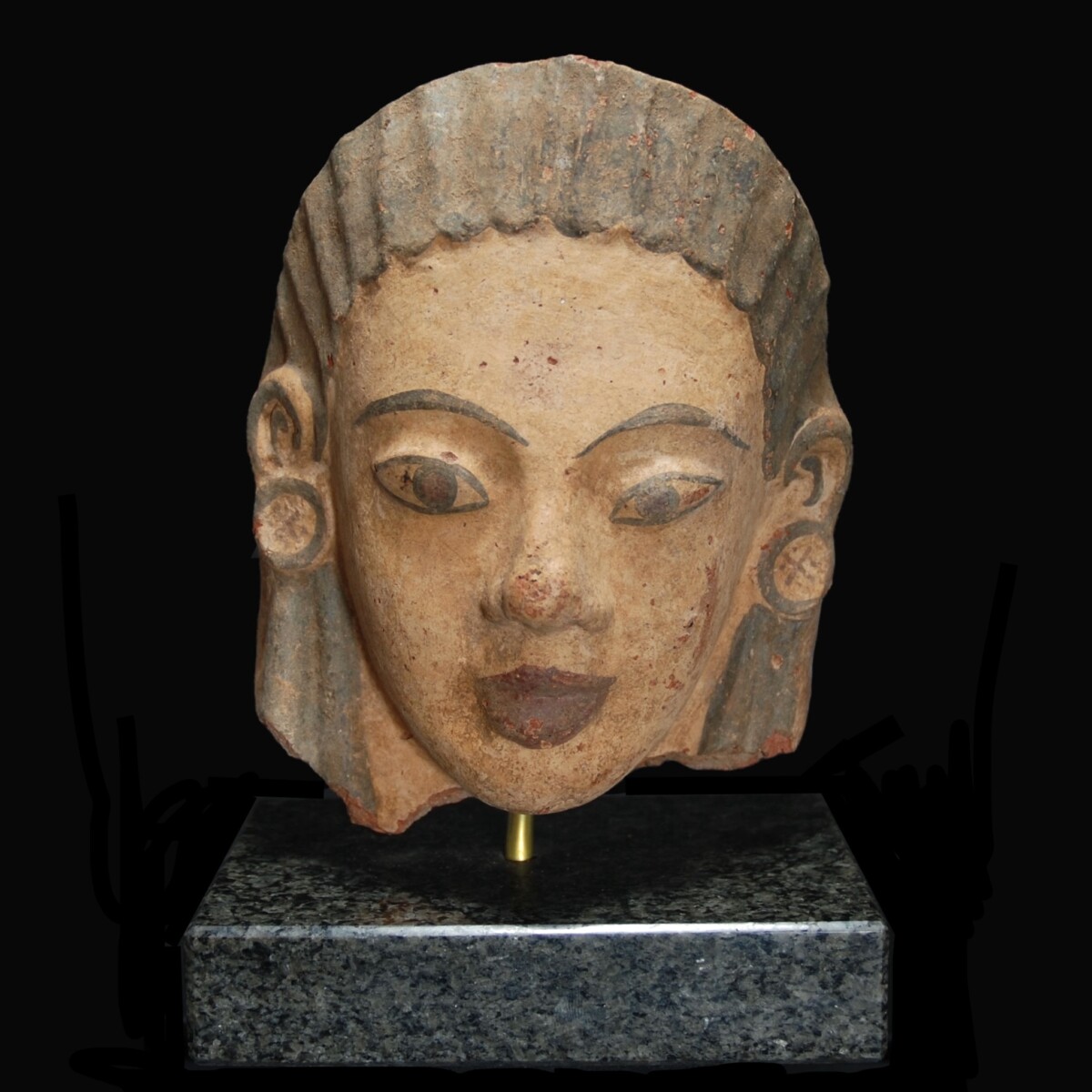
|
|
|
|
|
|
Etruria – Mid 6th century B.C.
|
Exceptionally beautiful terracotta antefix in form of an archaic woman’s head with abundantly preserved painting. The oval face with almond-shaped eyes with black pupils, above finely drawn brows, and a straight, slightly rounded nose. The mouth is closed with red full lips, which are formed to a gentle smile. The black, wavy hair frames the face and cascades behind the ears in an Egyptized style to the shoulders. The woman wears large, round earrings, which are decorated with a cross with dots between the bars. She has a veil with a red band pulled over the back of the head. Possibly from Cerveteri. Mounted on a heavy granite base. On the back of the base a collection label. With a TL test confirming the age.
|
Provenance: Private collection Carl Otto Tièche (1899-1989), Nidau, Switzerland, acquired prior to 1979. In the same year by descent to his nephew Robert Tièche, Kappel, Switzerland. Handed over in 2012 to Galleria Serodine in Ascona, Switzerland. There sold on 10 October 2012 to Dr. Fred and Sylvia Legrain, Wabern, Switzerland. Thence in a family estate. WIth a copy of the invoice from Galleria Serodine and a provenance confirmation by Robert Tièche from 2012. With a TL test confirming the age.
Dimensions: 16.8 cm high
Price: 16 000 Euro
|
|
|
Etrurien – Mitte 6. Jahrhundert v. Chr.
|
Außergewöhnlich schönes Terrakotta-Antefix in Form eines archaischen Frauenkopfes mit reich erhaltener Bemalung. Der ovale Kopf mit mandelförmigen Augen mit schwarzer Pupille, fein geschwungenen Brauen darüber und einer geraden, leicht abgerundeten Nase. Der Mund geschlossen mit roten vollen Lippen, die zu einem zärtlichen Lächeln geformt sind. Das schwarze, wellige Haar rahmt das Gesicht ein und fällt hinter den Ohren im ägyptisierenden Stil auf die Schultern. Die Frau trägt große runde Ohrringe, die mit einem Kreuz mit Punkten zwischen den Balken verziert sind. Über den Hinterkopf hat sie einen Schleier mit einem roten Band gezogen. Wohl aus Cerveteri. Auf schwerem Granitsockel montiert. Hinten am Sockel ein Sammlungsetikett. Mit TL-Test, der das Alter bestätigt.
|
Provenienz: Privatsammlung Carl Otto Tièche (1899-1989), Nidau, Schweiz, erworben vor 1979. In diesem Jahr durch Erbschaft an seinen Neffen Robert Tièche, Kappel, Schweiz. Von diesem 2012 an die Galleria Serodine in Ascona, Schweiz, übergeben. Dort verkauft am 10. Oktober 2012 an Dr. Fred und Sylvia Legrain, Wabern, Schweiz. Seitdem in Familienbesitz. Mit Kopie der Rechnung der Galleria Serodine und Provenienzbestätigung von Robert Tièche aus dem Jahr 2012. Mit TL-Test, der das Alter bestätigt.
Höhe: 16,8 cm
Preis: 16.000 Euro
|
|
|
|
Selected Artworks of the Month:
|
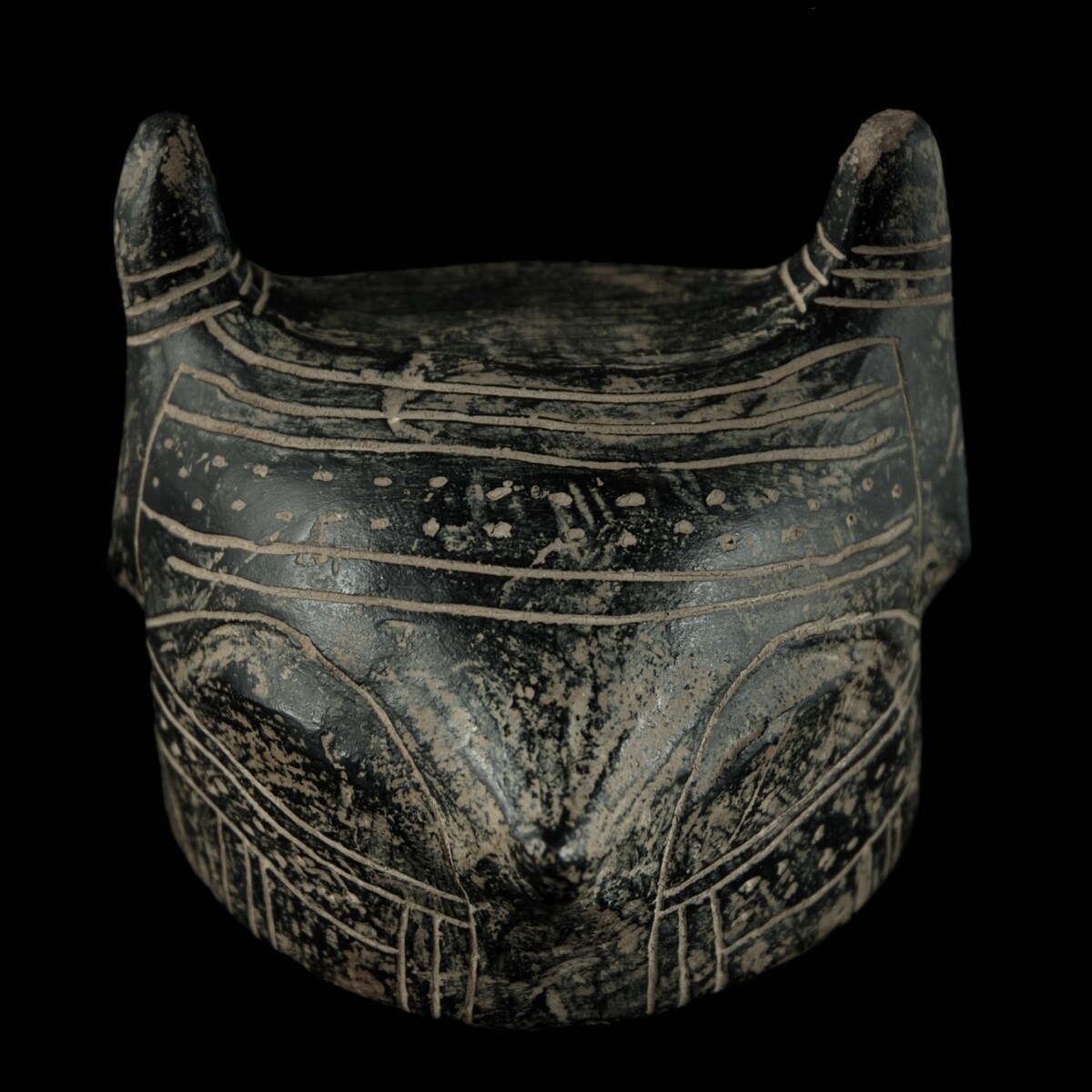
|
|
|
|
|
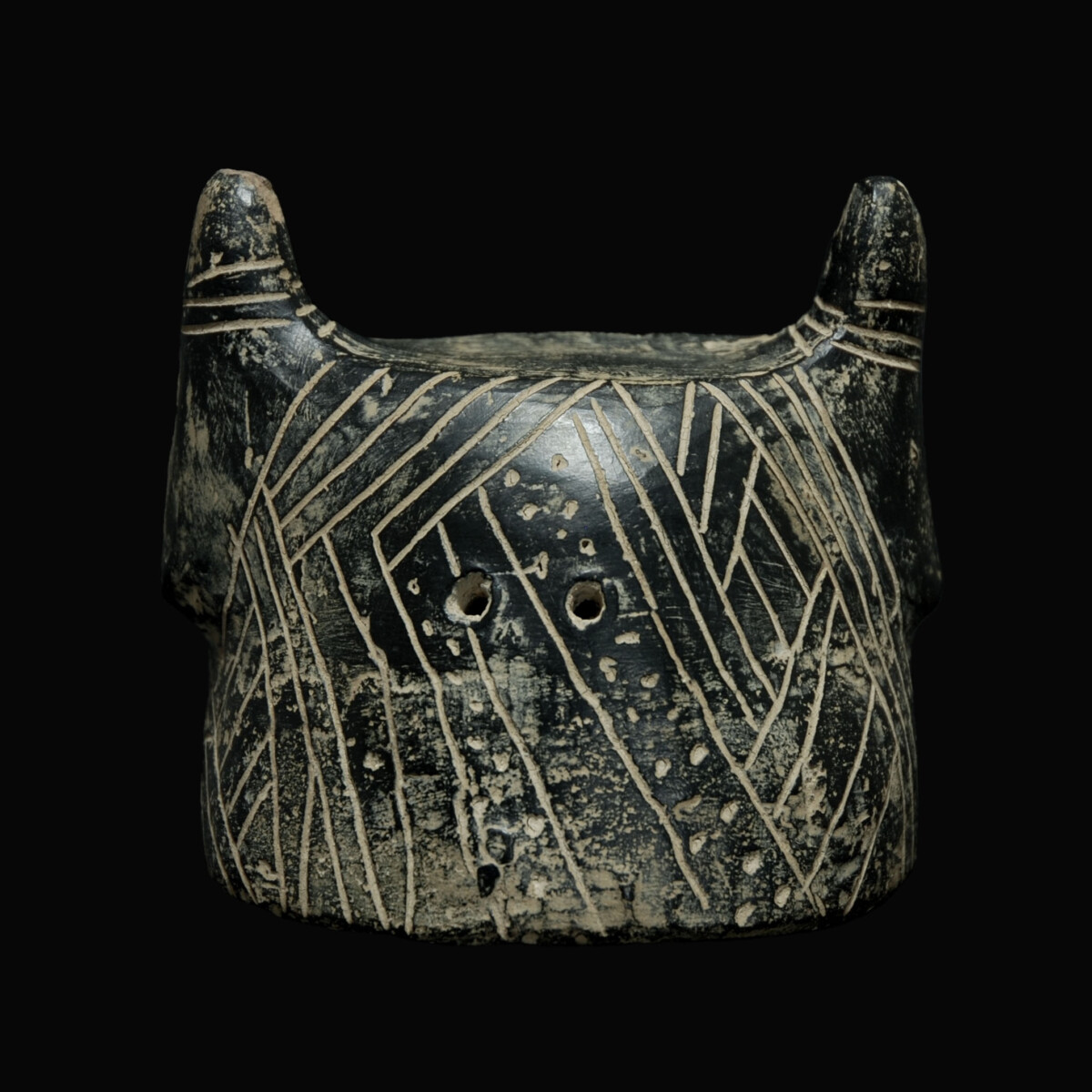
|
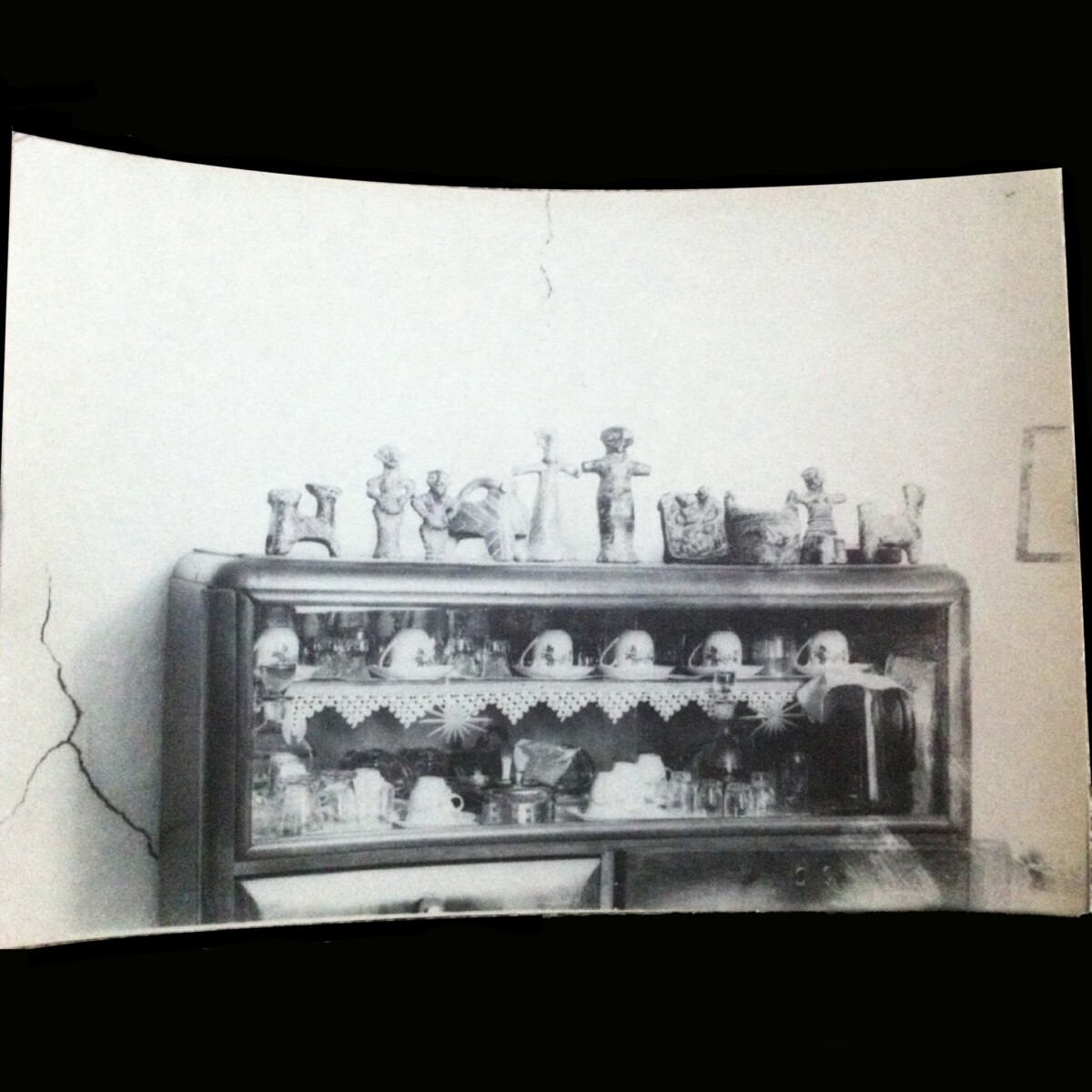
|
|
Southeastern Europe – 5000-4500 B.C.
|
Large expressive terracotta lid in form of a bird’s face, possibly an owl from the Neolithic Vinča culture. The cylindrical lid with a long, finely ribbed, pointy beak and raised, angular ears. The sickle-shaped eyes sculpturally protruding. The entire lid is decorated with incised lines and punched dots. On the back two perforations for suspension on the vessel. Zoomorphic lids such as the present one had apotropaic functions and should protect important storage vessels. See for the type the so-called “Prosopomorphic Lid Faces” in the archaeologic collection of the Faculty of Philosophy in Belgrade and the Belgradian City Museum. Possibly from the excavation site Vinča – belo brdo in Serbia. Accompanied by a TL test of the University of Vienna.
|
Provenance: From the well known Vinča collection of Dusan Jovanovic (1956-2015), since 1970 in Austria. With a copy of an old collection picture from the 1970s. Accompanied by a TL test.
Dimensions: 24 cm high
Price: 12 000 Euro
|
|
|
Südosteuropa – 5000-4500 v. Chr.
|
Großer ausdrucksstarker Terrakotta-Deckel in Form eines Vogelgesichts, wohl einer Eule, aus der neolithischen Vinča-Kultur. Der zylindrische Deckel mit langem, fein geripptem, spitzem Schnabel und aufgestellten, eckigen Ohren. Die sichelförmigen Augen stehen plastisch hervor. Der gesamte Deckel ist mit eingeritzten Linien und eingestochenen Punkten verziert. Auf der Rückseite zwei Lochungen zur Befestigung am Gefäß. Zoomorphe Deckel wie dieser hatten apotropäische Funktion und sollten bedeutende Vorratsgefäße beschützen. Vergleiche zum Typus die sogenannten „Prosopomorphic Lid Faces“ in der archäologischen Sammlung der philosophischen Fakultät in Belgrad und im Belgrader Stadtmuseum. Wohl aus der Ausgrabungsstätte Vinča – belo brdo in Serbien. Mit TL-Test der Universität Wien.
|
Provenienz: Aus der bekannten Vinča-Sammlung von Dusan Jovanovic (1956-2015), seit 1970 in Österreich. Mit Kopie eines alten Sammlungsfotos aus den 1970er Jahren. Mit TL-Test.
Dimensionen: 10,5 cm x 10,5 cm
Preis: 12.000 Euro
|
|
|
|
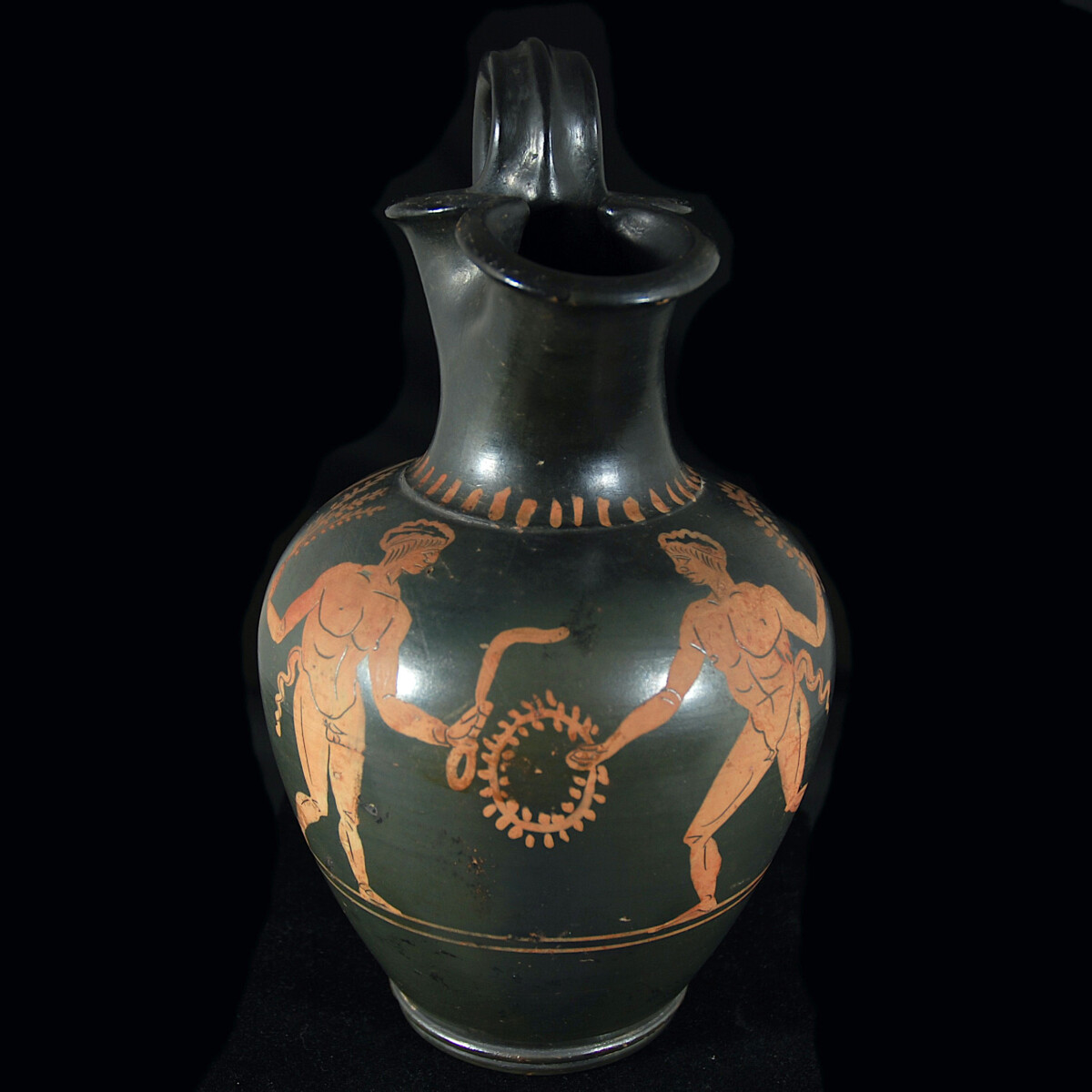
|
|
|

|
|
Etruria – 1st half of 4th century B.C.
|
Beautifully preserved red-figure oinochoe from an Etruscan workshop in Chiusi. The bulbous vessel stands on a flat base accentuated with profiles. The handle with a raised middle ridge is pulled up, therefore the type of jug is called “Schweifhenkelkanne” in German. The image area depicts on the front two unclothed satyrs facing each other. They are recognizable as young athletes with filets, the left one holds a strigilis and a plant with three branches. The other one rushes and holds two victory wreaths in his hand. Below the handle a palmette, on the sides spirals. On the corpus an old collection label with the number 391. See for the type the large jug of the same size with dancing satyrs in the Museo Nazionale Etrusco di Chiusi, published in “antike-tischkultur.de”, Etruscan clay jugs, type 9.
|
Provenance: From the private collection of the French archaeologist Louis-Gabriel Bellon (1819-1899). For over 120 years in a family estate. Accompanied by a French antiquities passport.
Dimensions: 24 cm high
|
|
|
Etrurien – 1. Hälfte 4. Jahrhundert v. Chr.
|
Wunderbar erhaltene rotfigurige Oinochoe aus einer etruskischen Werkstatt in Chiusi. Das bauchige Gefäß steht auf einer durch Profile akzentuierten, flachen Basis. Der Henkel mit erhöhtem Mittelgrat ist hochgezogen, weshalb der Kannentyp im deutschen auch „Schweifhenkelkanne“ genannt wird. Die Bildfläche zeigt vorne zwei einander zugewandte, unbekleidete Satyre. Sie sind als junge Athleten mit Haarbändern erkennbar, der linke hält eine Strigilis und eine Pflanze mit drei Zweigen. Der andere eilt im Laufschritt herbei und hält zwei Siegeskränze in der Hand. Unter dem Henkel eine Palmette, seitlich davon Spiralen. Am Korpus ein altes Sammlungsetikett mit der Nummer 391. Vergleiche zum Typus die gleich große Kanne mit tanzenden Satyren im Museo Nazionale Etrusco di Chiusi, publiziert in „antike-tischkultur.de“, etruskische Tonkannen, Typ 9.
|
Provenienz: Aus der Privatsammlung des französischen Archäologen Louis-Gabriel Bellon (1819-1899). Seit über 120 Jahren in Familienbesitz. Mit französischem Antikenpass.
Höhe: 24 cm
Preis: 12.000 Euro
|
|
|
|
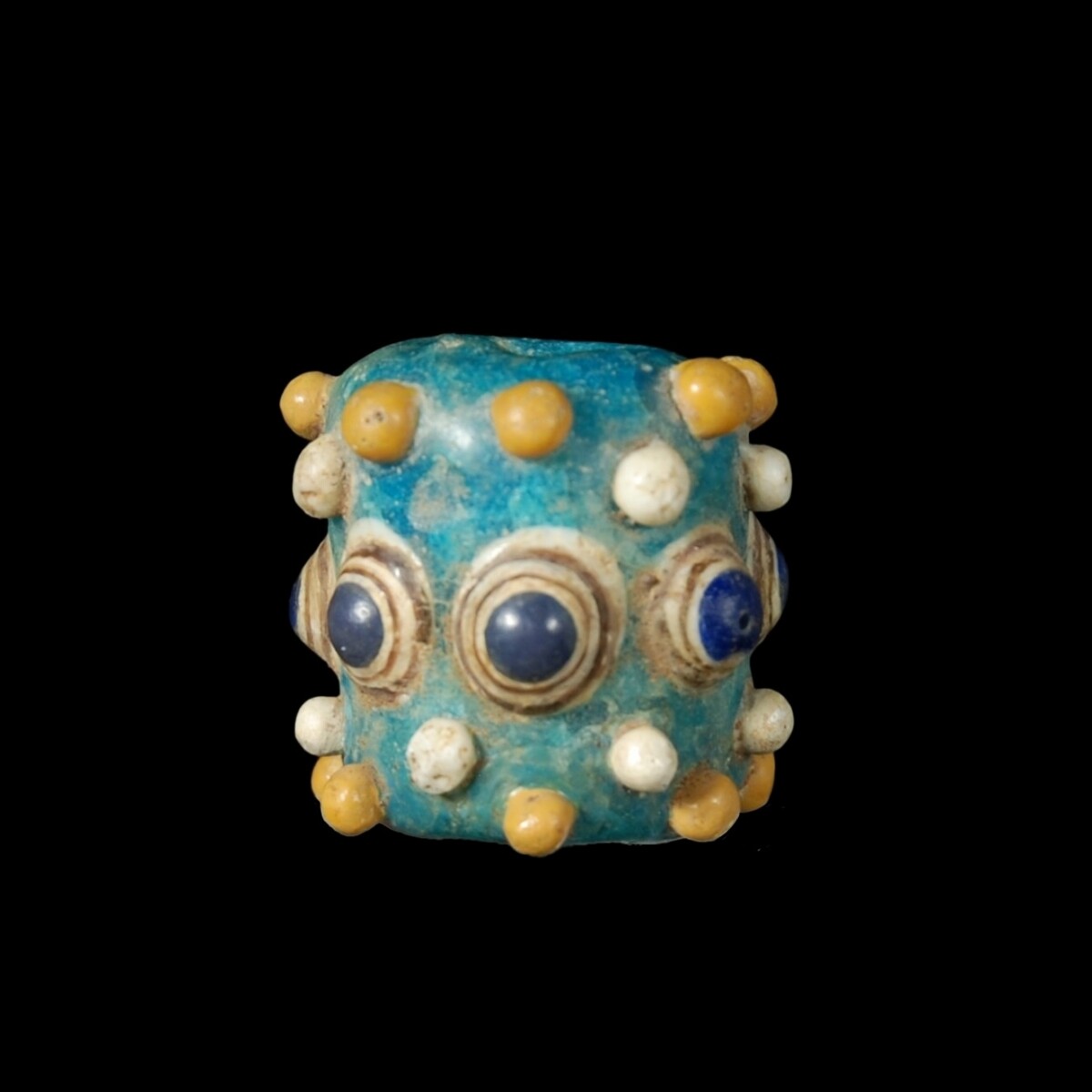
|
|
|
|
|
|
Phoenicia/Carthage – 4th-3rd century B.C.
|
Extraordinarily large and finely worked out Phoenician eye bead of opaque turquoise glass. Around the tubular body seven finely worked out glass beads are applied. The eyes consist of blue glass spheres which are framed by brown and white circles. Above and below the eyes yellow and white glass spheres are applied.
|
Provenance: French collection H. A., Paris, acquired between 1980 and 2000.
Dimensions: 3 cm x 3 cm
Price: 3 800 Euro
|
|
|
Phönizien/Karthago – 4.-3. Jahrhundert v. Chr.
|
Außergewöhnlich große und fein gearbeitete phönizische Augenperle aus opakem türkisem Glas. Um den röhrenförmigen Körper sind sieben fein gearbeitete Glasaugen appliziert. Die Augen bestehen aus blauen Glaskugeln, die von braunen und weißen Kreisen umgeben sind. Über und unter den Augen applizierte gelbe und weiße Glaskügelchen. Wohl aus Karthago.
|
Provenienz: Französische Sammlung H. A., Paris, erworben zwischen 1980 und 2000.
Dimensionen: 3 cm x 3 cm
Preis: 3.800 Euro
|
|
|
|
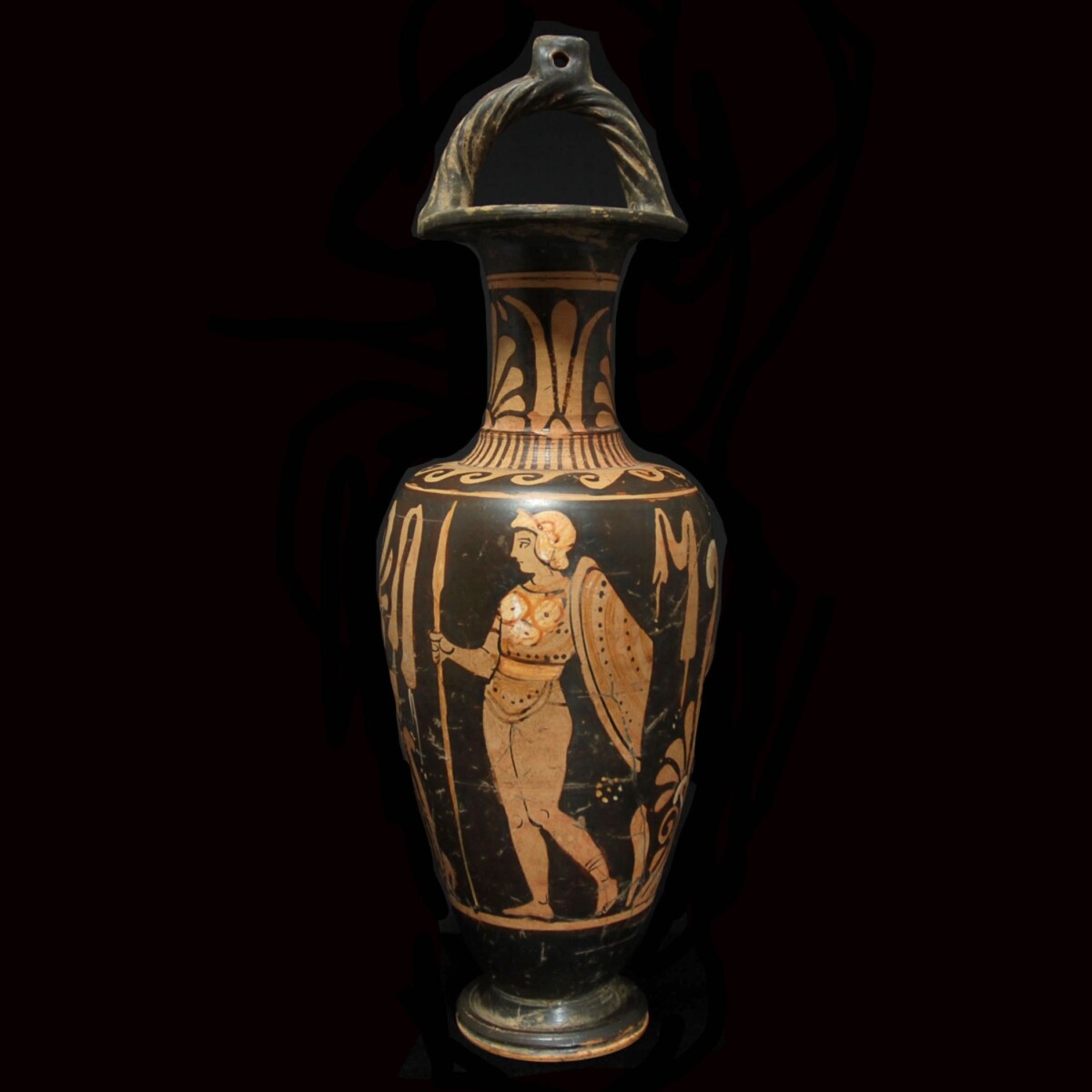
|
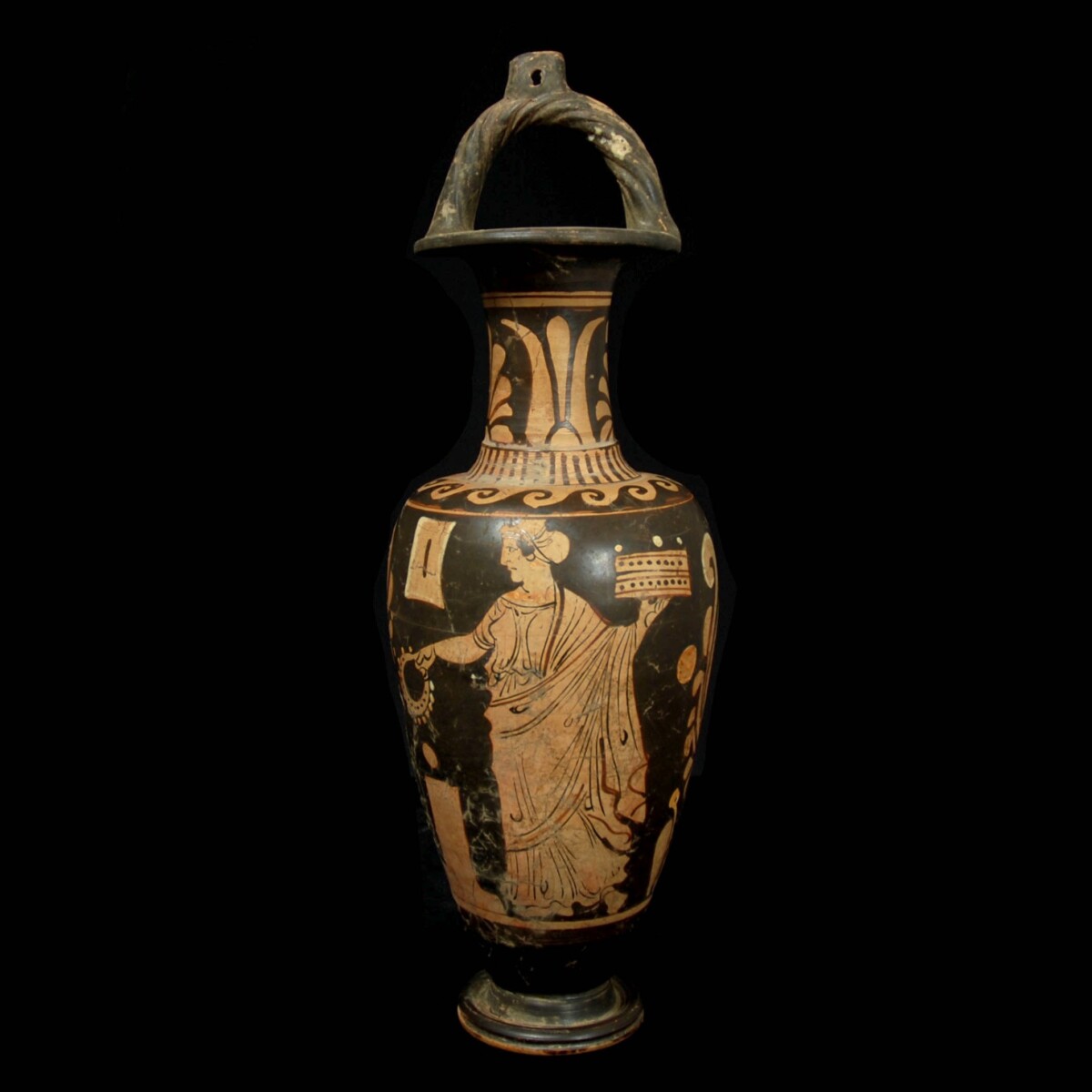
|
|
Greece/Campania – 340-330 B.C.
|
Beautifully preserved basket handle amphora from Capua, which is attributed to the Libation Painter. One side depicts a Samnite warrior with helmet, shield and lance, who typically wears a trefoil-plate cuirass. The warrior faces to the left and stands with the weight on his right leg, the left one slightly bent backwards. Behind him a taenia, the adornment of glory for the winner. The other side depicts a woman in a chiton with a himation thrown over the left arm. She holds a dotted cista in her left hand up in the air. With the right hand she holds a filet over an altar. Between the images abundant palmette decoration. On the shoulder a black wavy band. On the neck a rare depiction of lotus blossoms between palmettes. On the rim sits the eponymous twisted stirrup or "basket handle". A perforation for suspension.
|
Provenance: German private collection R. K., Hessen, Germany, acquired prior to 1980.
Dimensions: 36.6 cm high
|
|
|
Griechenland/Kampanien – 340-330 v. Chr.
|
Wunderbar erhaltene Bügelhenkelamphora aus Capua , die dem Libation-Maler zugewiesen ist. Die eine Seite zeigt einen samnitischen Krieger mit Helm, Schild und Lanze, der einen typischen Dreischeibenpanzer trägt. Der Krieger blickt nach links und steht mit dem Gewicht auf seinem rechten Bein, das linke leicht nach hinten abgewinkelt. Hinter ihm eine Tänie, der Ehrenschmuck des Siegers. Die andere Seite zeigt eine Frau im Chiton mit ein um den linken Arm geworfenes Himation. Sie hält eine gepunktete Cista mit der Linken in die Höhe. In der rechten Hand hält sie einen Haarkranz über einen Altar. Zwischen den Bildern reiche Palmetten-Dekoration. Auf der Schulter ein schwarzes Wellenband. Am Hals die seltene Darstellung von Lotusblüten zwischen Palmetten. Am Rand sitzt schließlich der namengebende tordierte Bügelhenkel auf. Eine Lochung zur Aufhängung.
|
Provenienz: Deutsche Privatsammlung R. K., Hessen, erworben vor 1980.
Höhe: 36,6 cm
Preis: 8.000 Euro
|
|
|
|
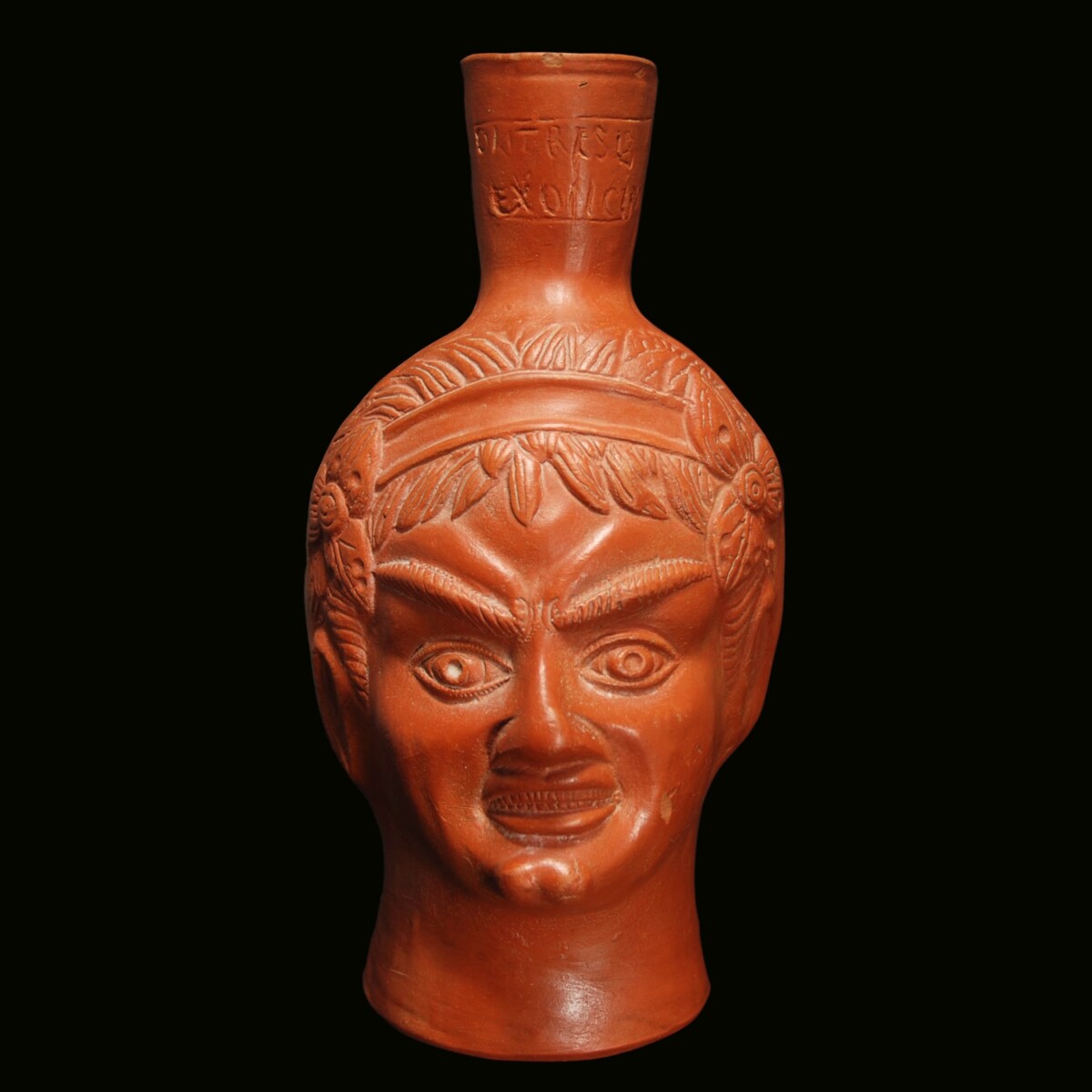
|
|
|
|
|
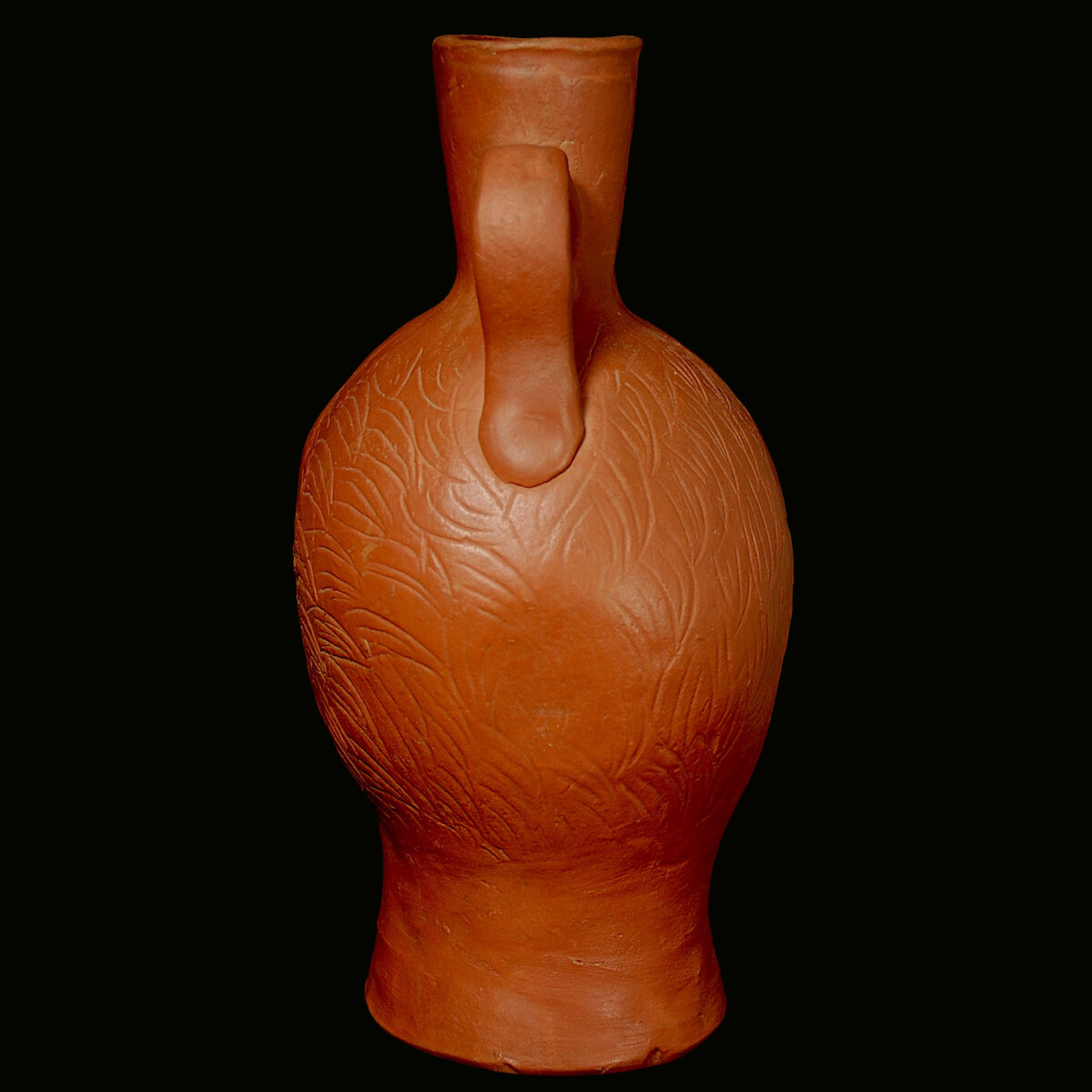
|
|
Roman Empire – around 300 A.D.
|
Large and extraordinarily beautifully preserved vase of the Red-Slip ware or terra sigillata in form of a satyr’s head. The expressive face with grotesque features. The sculpturally bulging, ribbed brows turn towards the nose and form far protruding forehead wrinkles. The satyr has his eyes open to a starry gaze, and shows his teeth above a far protruding chin-dimple. On his head he wears a diadem, which is adorned on both sides with rosettes. Under the diadem thick strands cascade on his forehead. The high, funnel-shaped spout has a stamped, two-line inscription mentioning the manufacturer: “OLITRESIS EX OFICIS” - from the workshop of Olitresis. The vase made from models has a handle that starts on the shoulder and reaches to the round back of the head. The hair on the back of the head was incised with the graver into the clay. The vase originates from the Roman province Africa proconsularis, today Tunisia, possibly from Henchir Es-Srira. See for a very similar vase the example in the Museum of Fine Arts Budapest with the inventory number 20025.A, though it is not signed. In the publication about the vase in Budapest the present vase is mentioned. See: Dénes Gabler und András Márton “Head-Pots in the Antiquities Collection”, p. 51. In „Bulletin du Musée Hongrois des Beaux-Arts, 2008, No. 108-109.
|
Provenance: German art market 1990s, from there acquired by a Dutch collection. 2008 published in: Dénes Gabler and András Márton “Head-Pots in the Antiquities Collection”, p. 51. In „Bulletin du Musée Hongrois des Beaux-Arts, 2008, No. 108-109 (without picture). Last in the French art market.
Dimensions: 25 cm high
Price: 6 000 Euro
|
|
|
Römisches Reich – um 300 n. Chr.
|
Große und außerordentlich schön erhaltene Vase der Red-Slip-Ware oder Terra Sigillata in Form eines Satyr-Kopfes. Das ausdrucksstarke Gesicht mit grotesken Zügen. Die plastisch hervorstehenden, gerippten Brauen senken sich zur Nase ab und bilden weit hervorquellende Stirnfalten. Der Satyr hat die Augen zum starren Blick geöffnet, er zeigt seine Zähne über einem weit hervorstehenden Kinn-Grübchen. Am Kopf trägt er ein Diadem, das auf beiden Seiten mit Rosetten verziert ist. Unter dem Diadem fallen ihm dicke Strähnen in die Stirn. Der hohe, trichterförmige Ausguss trägt eine gestempelte, zweizeilige Inschrift, die den Hersteller nennt: „OLITRESIS EX OFICIS“ – aus der Werkstatt des Olitresis. Der Henkel der aus Modeln gefertigten Vase setzt an der Schulter an und reicht bis zum runden Hinterkopf. Das Haar am Hinterkopf wurde mit dem Stichel in den Ton graviert. Die Vase stammt aus der römischen Provinz Africa Proconsularis im heutigen Tunesien, wohl aus Henchir Es-Srira. Vergleiche eine sehr ähnliche Vase im Museum of Fine Arts Budapest mit der Inventarnummer 20025.A, die allerdings nicht signiert ist. In der Publikation zu dieser Budapester-Vase wird unsere Vase erwähnt. Siehe dazu: Dénes Gabler und András Márton „Head-Pots in the Antiquities Collection“, S. 51. In „Bulletin du Musée Hongrois des Beaux-Arts, 2008, Nr. 108-109.
|
Provenienz: Deutscher Kunstmarkt 1990er Jahre, dort erworben von einer niederländischen Sammlung. 2008 publiziert in: Dénes Gabler und András Márton „Head-Pots in the Antiquities Collection“, S. 51. In „Bulletin du Musée Hongrois des Beaux-Arts, 2008, Nr. 108-109 (ohne Foto). Zuletzt im französischen Kunsthandel.
Höhe: 25 cm
Preis: 6.000 Euro
|
|
|
|
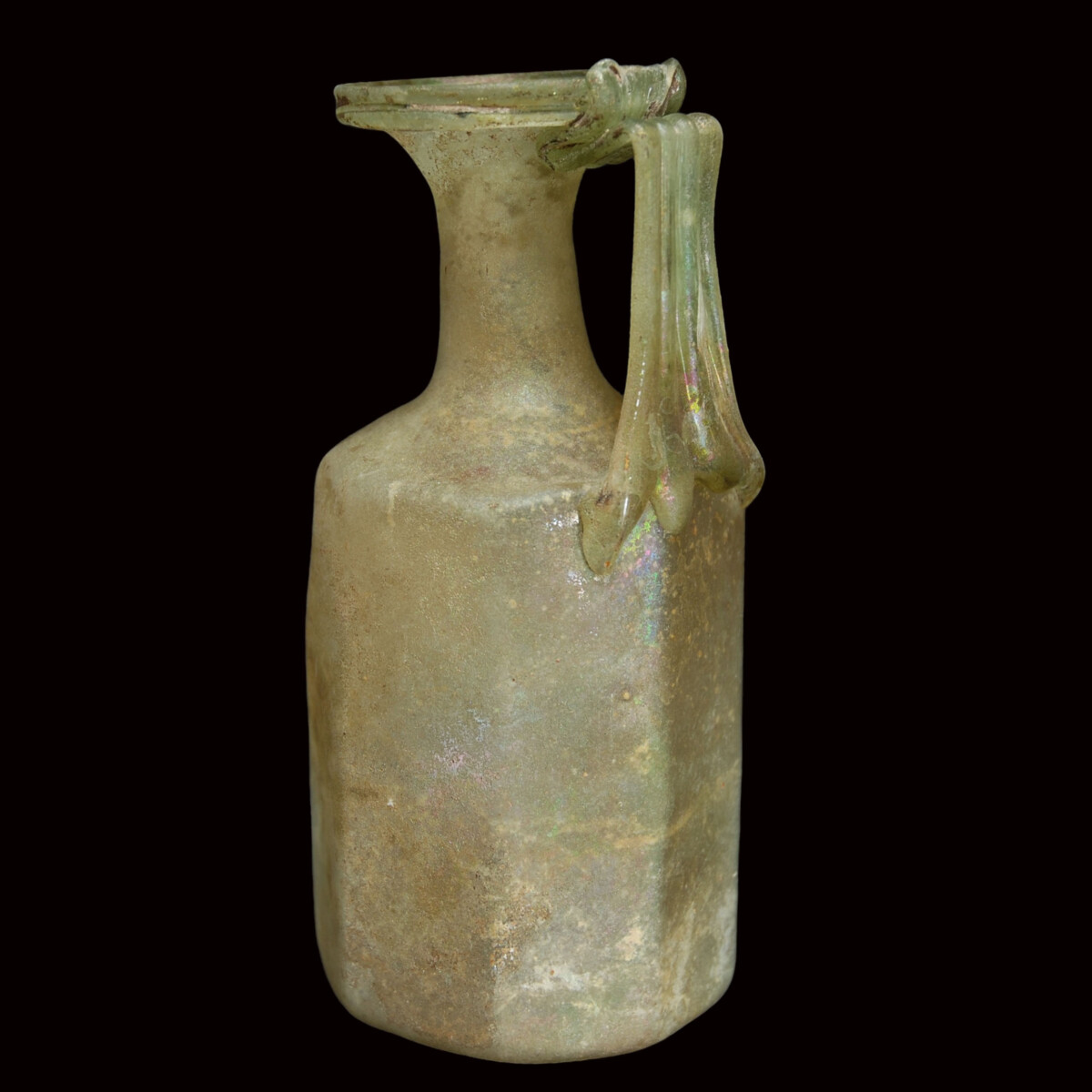
|
|
|
|
|
|
Roman Empire/Cyprus – 3rd century A.D.
|
Rare, octagonal flask of yellowish clear glass. The vessel stands on a slightly indented, curved base with star decoration. The eight, smooth sides end on the shoulders with semi-circular arches. The neck is cylindrical, the estuary far protruding with a profiled rim. The separately worked out, ribbed band handle reaches from the rim to the shoulder and broadens towards the bottom. From Cyprus. See for the type the flask in the Metropolitan Museum of Art with the Accession Number 74.51.110.
|
Provenance: Private collection Dr. Eugene Elovic, Miami Beach, USA. Thence in the Israeli art market.
Dimensions: 16.1 cm high
Price: 2 800 Euro
|
|
|
Römisches Reich/Zypern – 3. Jahrhundert n. Chr.
|
Seltene achteckige Flasche aus gelblichem Klarglas. Das Gefäß steht auf einer leicht nach innen gewölbten Basis mit Sterndekor. Die acht glatten Seiten schließen an der Schulter mit halbrunden Bögen ab. Der Hals ist zylindrisch, die Mündung weit ausladend mit profiliertem Rand. Der separat gearbeitete, gerippte Bandhenkel reicht vom Rand bis zur Schulter und verbreitert sich nach unten. Aus Zypern. Vergleiche zum Typus die Flasche im Metropolitan Museum of Art mit der Accession Number 74.51.110.
|
Provenienz: Privatsammlung Dr. Eugene Elovic, Miami Beach, USA. Danach im israelischen Kunsthandel.
Höhe: 16,1 cm
Preis: 2.800 Euro
|
|
|
|
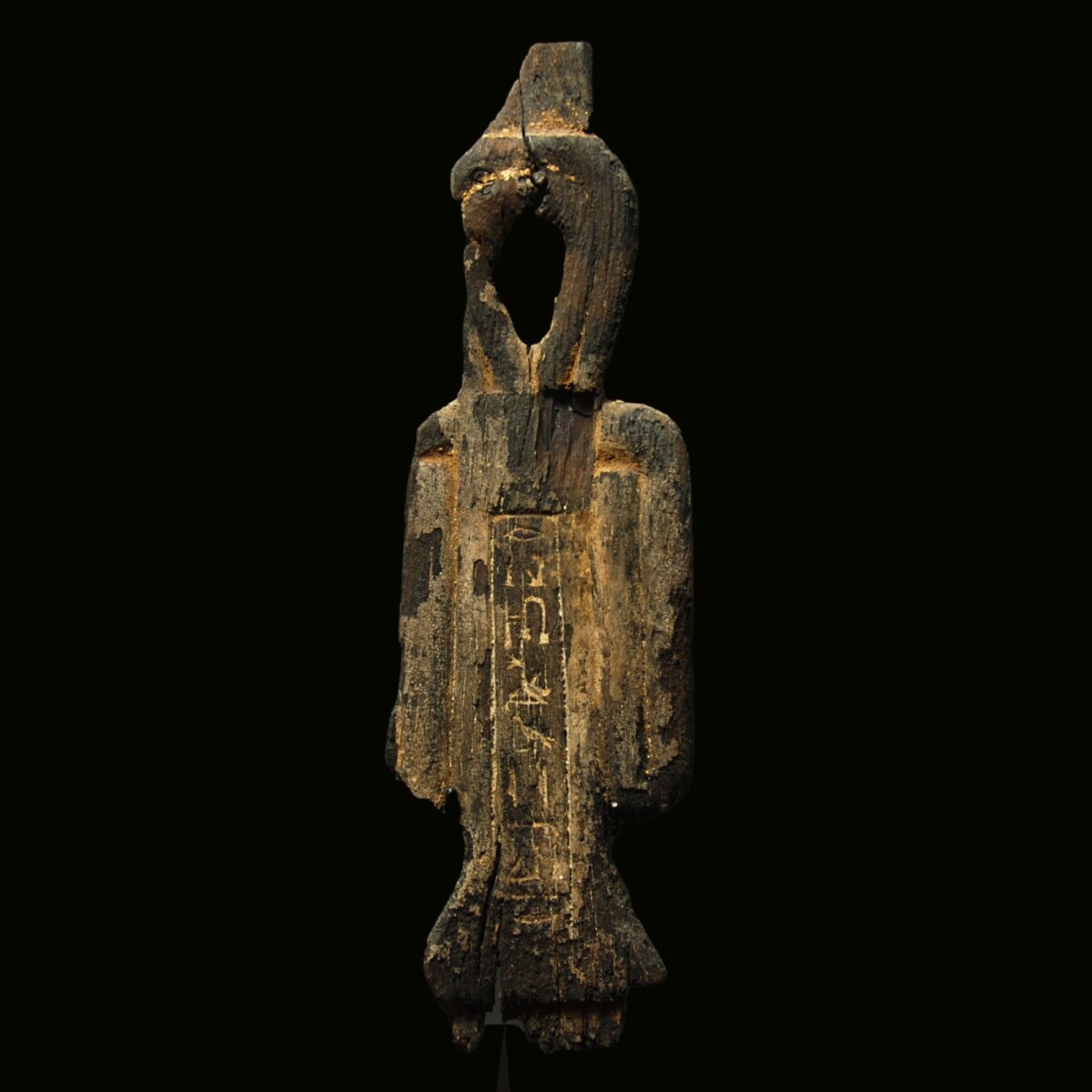
|
|
Egypt – New Kingdom, 18th dynasty, 1550-1292 B.C.
|
Large and important wood tyet symbol (also called as knot of Isis) with remains of gilt. In contrast to the ankh sign the side arms of a knot of Isis are facing downwards. The front with a large, ovoid head, long arms and broadening legs. A vertical inscription with hieroglyphs mentioning the name of the owner Tjay runs along the belly. The complete translation reads: “Oh Osiris, the scribe Tjay, justified.” Protruding tenons on top and at the bottom suggest that this rare wood knot of Isis was part of a furniture. Possibly it was mounted on the back rest of a chair of a funerary endowment. See the completely preserved chair of Hatnefer dating to the period of Hatshepsut, today in the Metropolitan Museum of Art with the Accession Number 36.3.152. The tyet symbol was used in a sepulchral context to protect the deceased from all dangers in the afterlife. Mounted.
|
Provenance: Old British collection Boyd, acquired prior to 1930. Thence in a family estate. On 30 May 2015 auctioned with Pierre Bergé in Paris, lot 19. There acquired by the private collection Jean Deriat (1922-2016), thence in a family estate.
Dimensions: 19.5 cm high
Price: 2 800 Euro
|
|
|
Ägypten – Neues Reich, 18. Dynastie, 1550-1292 v. Chr.
|
Großes und bedeutendes Tit-Symbol (das auch als Isis-Knoten bezeichnet wird) aus Holz mit Resten von Vergoldung. Im Unterschied zum Anch-Zeichen sind beim Isisknoten die Seitenarme nach unten geklappt. Die Vorderseite mit großem, ovoidem Kopf, langen Armen und nach unten breiter werdenden Beinen. Am Bauch verläuft eine vertikale Inschrift in Hieroglyphen, die den Namen des Besitzers Tjay nennt. Die komplette Übersetzung lautet: „Oh Osiris, der Schreiber Tjay, gerechtfertigt.“ Vorstehende Zapfen oben und unten lassen vermuten, dass dieser seltene Isis-Knoten aus Holz Teil eines Möbels war. Wahrscheinlich war es in die Rückenlehne eines Sessels der Grabausstattung gesteckt. Vergleiche dazu etwa den komplett erhaltenen Sessel der Hatnefer aus der Zeit der Hatschepsut, heute im Metropolitan Museum of Art mit der Accession Number 36.3.152. Das Tit-Symbol wurde im sepulkralen Kontext verwendet, um den Verstorbenen vor allen Gefahren des Jenseits zu schützen. Gesockelt.
|
Provenienz: Alte britische Sammlung Boyd, erworben vor 1930. Danach in Familienbesitz. Am 30. Mai 2015 versteigert bei Pierre Bergé in Paris, Los 19. Dort erworben von der Privatsammlung Jean Deriat (1922-2016), danach in Familienbesitz.
Höhe: 19,5 cm
Preis: 2.800 Euro
|
|
|
|
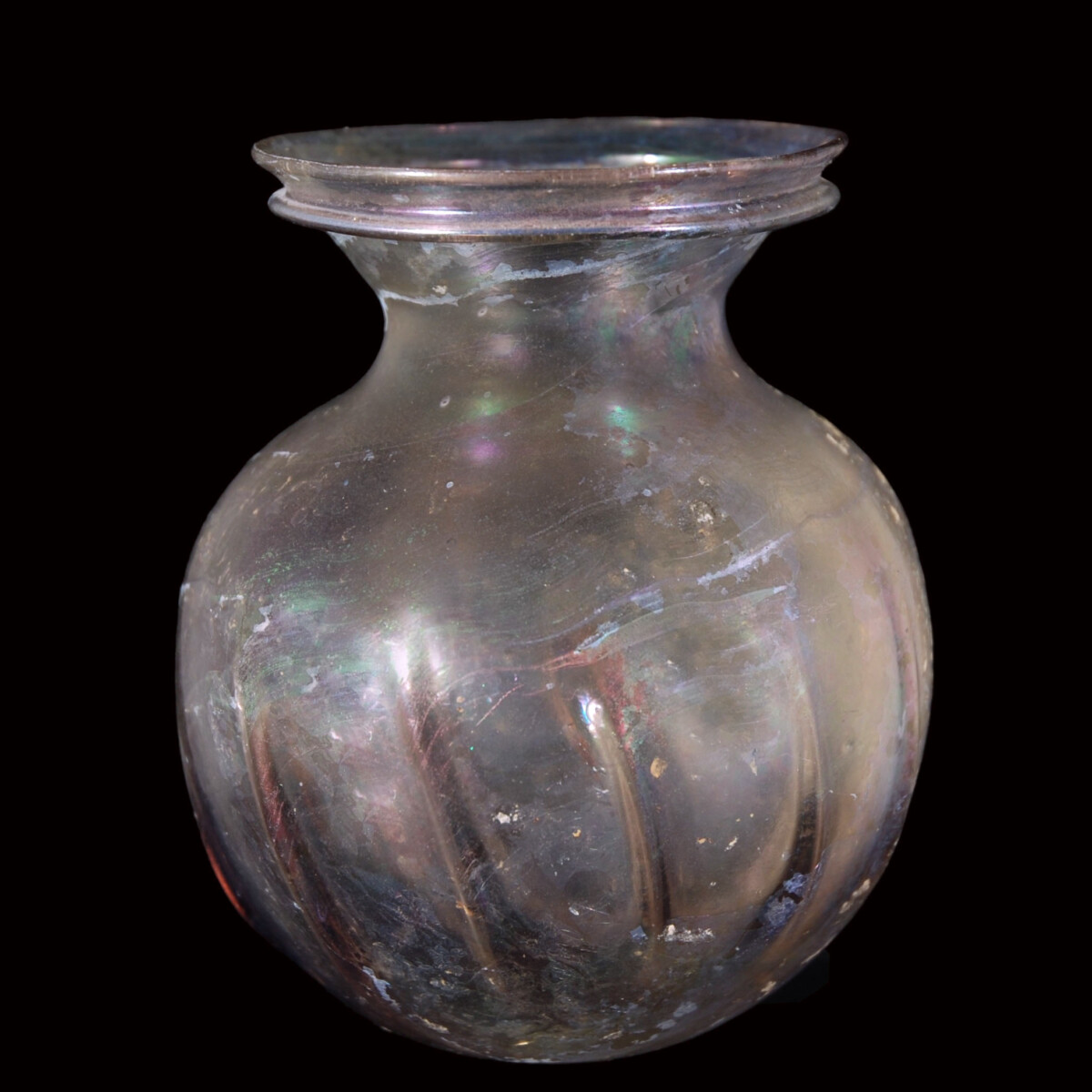
|
|
Roman Empire – 4th century A.D.
|
Large bulbous flask of violet shimmering clear glass. The base is slightly indented. On the corpus eleven ribs were pulled out from the wall with a pliers. The neck is convex, the estuary funnel-shaped, the rim is thickened and rounded. Below the rim is a narrow, swaged collar, which is open towards the interior of the vessel. An impressive, almost completely decolorised glass flask from Roman Syria. See for the color and form “Römisches, byzantinisches und frühmittelalterliches Glas – Sammlung Ernesto Wolf“, Hatje Cantz 2001, number 116.
|
Provenance: Israeli collection Z. Holtzmann, Tel Aviv.
Dimensions: 12 cm high
Price: 1 800 Euro
|
|
|
Römisches Reich – 4. Jahrhundert n. Chr.
|
Große kugelige Flasche aus violett schimmerndem Klarglas. Der Boden ist leicht nach innen gewölbt. Am Korpus wurden elf Rippen mit der Zange aus der Wandung gekniffen. Der Hals ist konvex, die Mündung trichterförmig, der Rand heiß verdickt und abgerundet. Unter dem Rand ist ein schmaler, gestauchter Kragen, der zum Gefäßinneren offen ist. Eine eindrucksvolle, fast völlig entfärbte Glasflasche aus dem römischen Syrien. Vergleiche zu Farbe und Form „Römisches, byzantinisches und frühmittelalterliches Glas – Sammlung Ernesto Wolf“, Hatje Cantz 2001, Nummer 116.
|
Provenienz: Israelische Sammlung Z. Holtzmann, Tel Aviv.
Höhe: 12 cm
Preis: 1.800 Euro
|
|
|
|
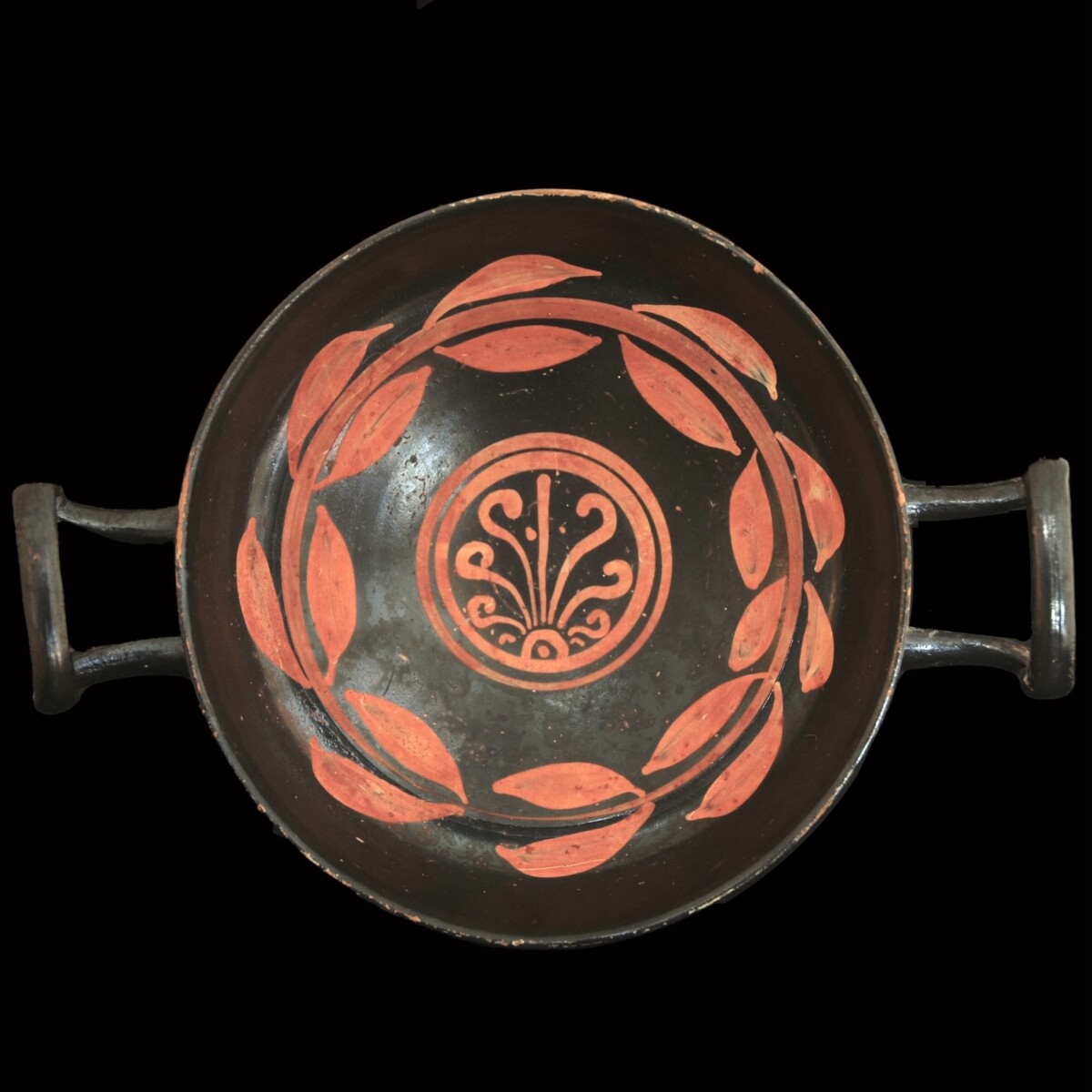
|
|
|
|
|
|
Greece/Apulia – 2nd half of 4th century B.C.
|
Beautifully preserved, thin-wall kylix from the Apulian workshop of the Red-Swan-Group. The bowl stands on a profiled foot ring and is glazed in black. Over the lustre the paint was applied in red color. The interior depicts in the tondo a palmette framed by red circles, a rare motive of this painter group. Followed by a laurel wreath, whose circular branch forms at the same time a raised rib. At the bottom between the handles two laurel branches, on one side with four, on the other side with five leaves. The handles themselves are curved upwards and reach approximately to the rim. See for the type Christie’s auction on 4 June 1999, lot 51. For the Red-Swan-Group see Konrad Schauenburg “Studien zur unteritalischen Vasenmalerei”, volume 3, Kiel 2001,pS. 36-43.
|
Provenance: Old Belgian private collection, thence André Munter Archeologie, Brussels, Belgium. There acquired on 10 December 2004 by another Belgian collection. With the original certificate by André De Munter, Brussels. On the back of the certificate a label with a stamp of a court inspection on 26 June 2009 with the signature of the law clerk F. Coene N.
Dimensions: 19.8 cm in diameter
Price: 1 400 Euro
|
|
|
Griechenland/Apulien – 2. Hälfte 4. Jahrhundert v. Chr.
|
Wunderbar erhaltene, dünnwandige Schale aus der apulischen Werkstatt der Red-Swan-Gruppe. Die Kylix steht auf einem profilierten Standring und ist schwarz glasiert. Über den Glanzton wurde schließlich die Malerei in roter Farbe aufgetragen. Die Innenseite zeigt im Tondo eine von roten Kreisen umrahmte Palmette, ein für diese Maler-Gruppe seltenes Motiv. Daran anschließend ein Lorbeerkranz, deren kreisförmiger Zweig gleichzeitig eine erhabene Rippe bildet. An der Unterseite sind zwischen den Henkel zwei Lorbeerzweige, auf der einen Seite mit vier, auf der anderen mit fünf Blättern aufgemalt. Die Henkel selbst sind außen nach oben gebogen und reichen etwa bis zum Rand. Vergleiche zum Typus Christie’s Auktion vom 4. Juni 1999, Los 51. Zur Red-Swan-Gruppe siehe Konrad Schauenburg „Studien zur unteritalischen Vasenmalerei“, Band 3, Kiel 2001, S. 36-43.
|
Provenienz: Alte belgische Privatsammlung, danach André Munter Archeologie, Brüssel. Dort erworben am 10. Dezember 2004 von einer anderen belgischen Sammlung. Mit Original-Zertifikat von André De Munter, Brüssel. Auf der Rückseite des Zertifikats ein Aufkleber mit Stempel einer Gerichtsbeschau vom 26. Juni 2009 mit der Unterschrift des Gerichtsschreibers F. Coene N.
Durchmesser: 19,8 cm
Preis: 1.400 Euro
|
|
|
|
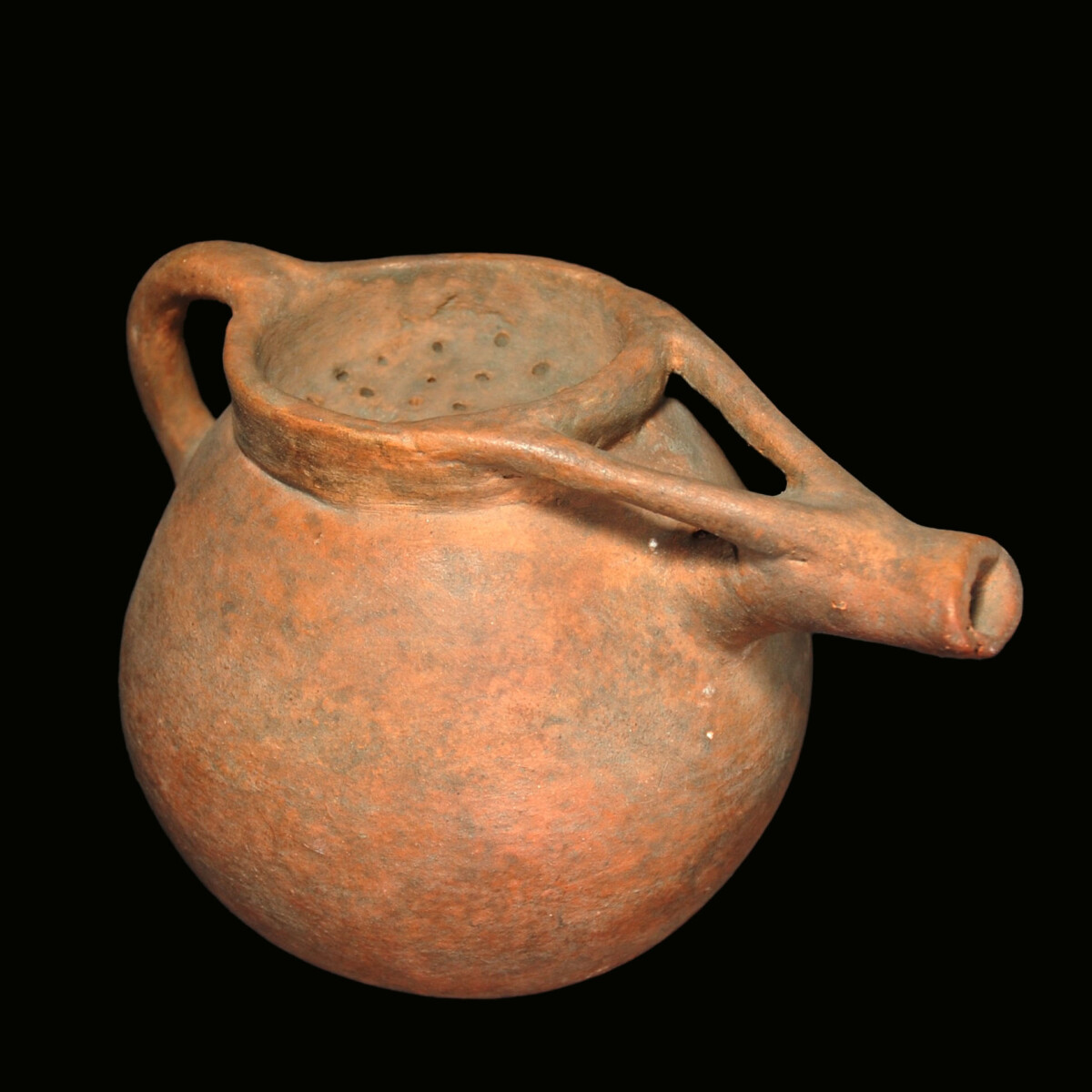
|
|
|
|
|
|
Iran/Luristan – 900-800 B.C.
|
Terracotta cult vessel formed by hand from the western Iranian province Luristan. The spherical corpus is flat at the bottom and slightly indented. The large pouring hole on top is worked out as a sieve, so that the offered libation only consists of a pure liquid. The spout is zoomorphically formed and depicts the head of a stylized ibex. The eyes are pierced below the horns, the horns themselves reach as bars to the rim of the vessel. At the back a semi-circular handle. The jug is a rare variation of the otherwise usual beak-spouted jugs, whose spouts have the form of stylized birds. See for this type another jug, whose spout is worked out in the form of a horned animal in the British Museum with the Registration Number 1933, 1211.1.
|
Provenance: German private collection, acquired prior to 1975 from the Munich gallery Kress.
Dimensions: 12.4 cm x 19.3 cm
Price: 1 200 Euro
|
|
|
Iran/Luristan – 900-800 v. Chr.
|
Handgeformtes Terrakotta-Kultgefäß aus der westiranischen Provinz Luristan. Der kugelige Korpus ist unten flach und leicht nach innen gewölbt. Das große Einfüllloch oben ist als Sieb ausgearbeitet, damit das mit dem Gefäß gespendete Trankopfer nur gereinigte Flüssigkeit enthielt. Der Ausguss ist zoomorph geformt und stellt den Kopf eines stilisierten Steinbocks dar. Die Augen sind unter den Hornansätzen gelocht, die Hörner selbst ziehen sich als Stege bis zum Rand des Gefäßes. Auf der Rückseite ein halbrunder Henkel. Die Kanne ist eine seltene Abwandlung der sonst üblichen Schnabelkannen, deren Ausgüsse die Form stilisierter Vögel haben. Vergleiche zu diesem Typus eine weitere Kanne, deren Ausguss in Form eines gehörnten Tieres ausgearbeitet ist im British Museum mit der Registration Number 1933,1211.1.
|
Provenienz: Deutsche Privatsammlung, erworben vor 1975 in der Münchner Galerie Kress.
Durchmesser: 12,4 cm x 19,3 cm
Preis: 1.200 Euro
|
|
|
|
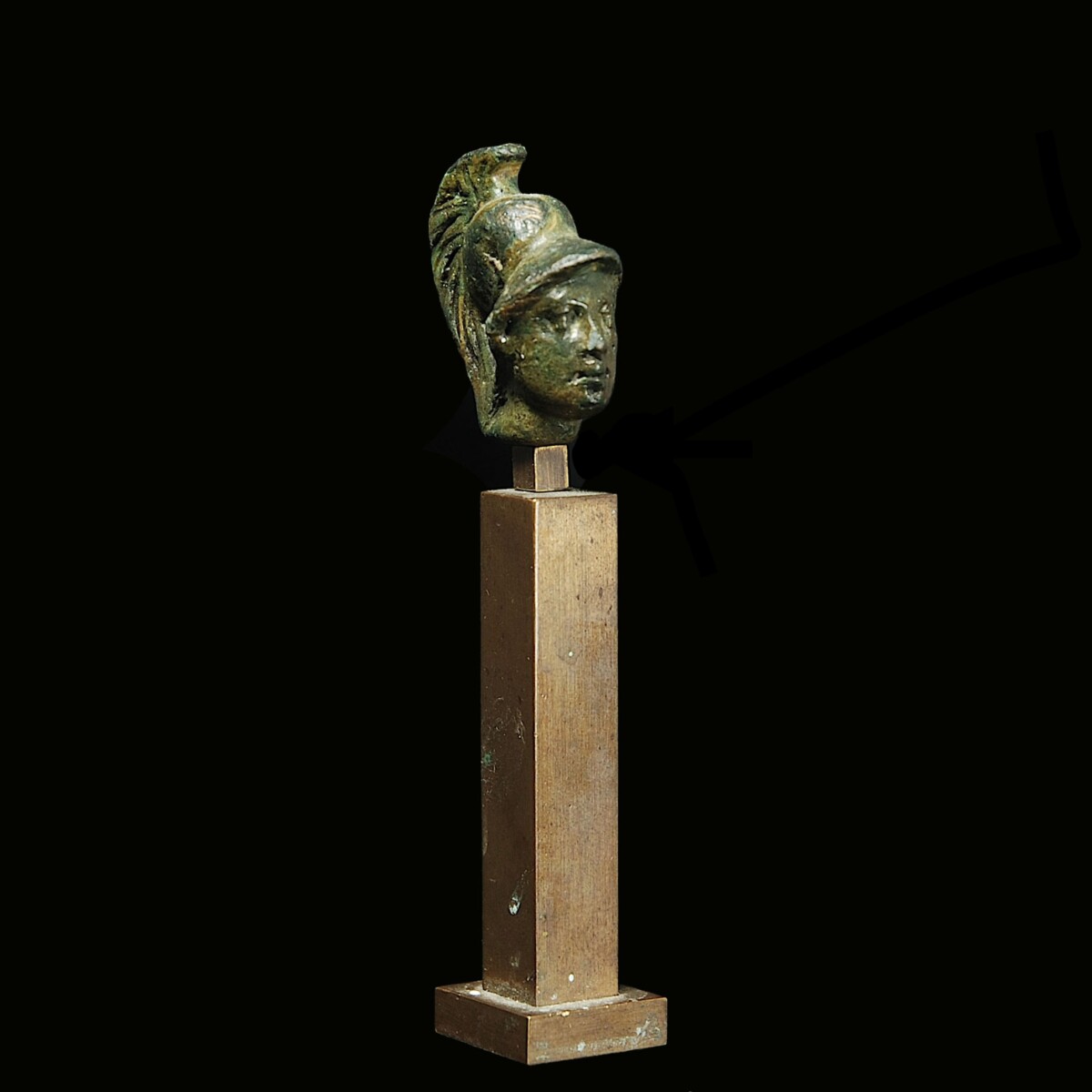
|
|
|
|
|
|
Roman Empire – 1st-2nd century A.D.
|
Finely worked out small bronze head of Minerva. The goddess of war and wisdom wears a Corinthian helmet with a high crest pulled into the forehead, where her thick hair protrudes. The round face with fine features, the eyes vigilant, the nose straight, the chin with a distinctive dimple. Mounted on a metal base.
|
Provenance: From a Breton collection, acquired in the early 2000s.
Dimensions: 3 cm high; 9 cm high (including base)
Price: 800 Euro
|
|
|
Römisches Reich – 1.-2. Jahrhundert n. Chr.
|
Fein gearbeitetes Bronze-Köpfchen der Minerva. Die Göttin des Krieges und der Weisheit trägt einen in die Stirn geschobenen korinthischen Helm mit hohem Helmbusch, unter dem ihr dichtes Haar hervorquillt. Das rundliche Gesicht mit feinen Zügen, die Augen wach, die Nase gerade, das Kinn mit markantem Grübchen. Auf einem Metallsockel montiert.
|
Provenienz: Aus einer bretonischen Sammlung, erworben Anfang der 2000er Jahre.
Höhe: 3 cm; Höhe mit Sockel: 9 cm
Preis: 800 Euro
|
|
|
|
|
|
|
CHRISTOPH BACHER ARCHÄOLOGIE ANCIENT ART GmbH
|
Galerie: Stubenring 20, A-1010 Wien
Showroom: Untere Viaduktgasse 55, A-1030 Wien
|
|
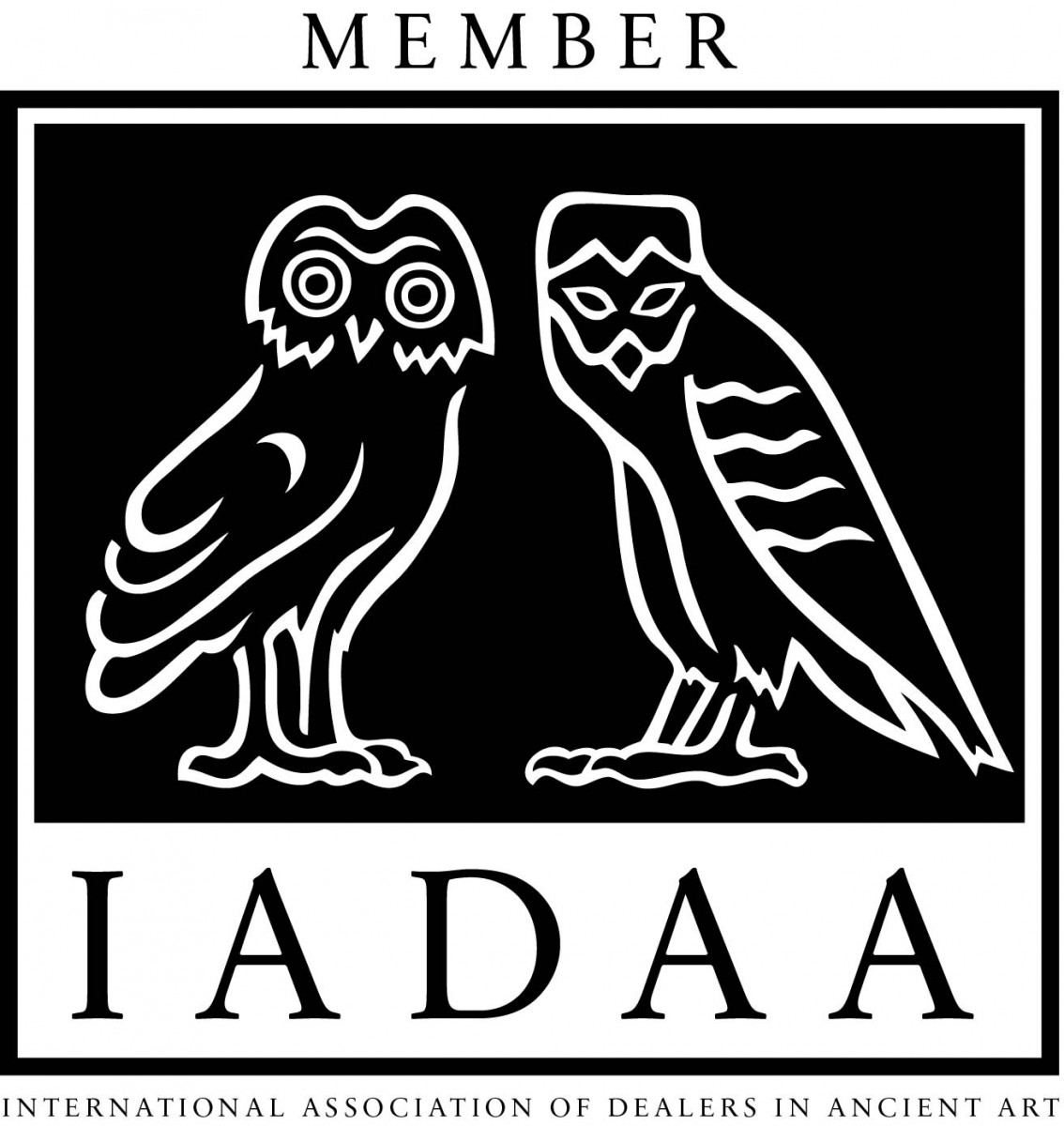
|
|
|
|


